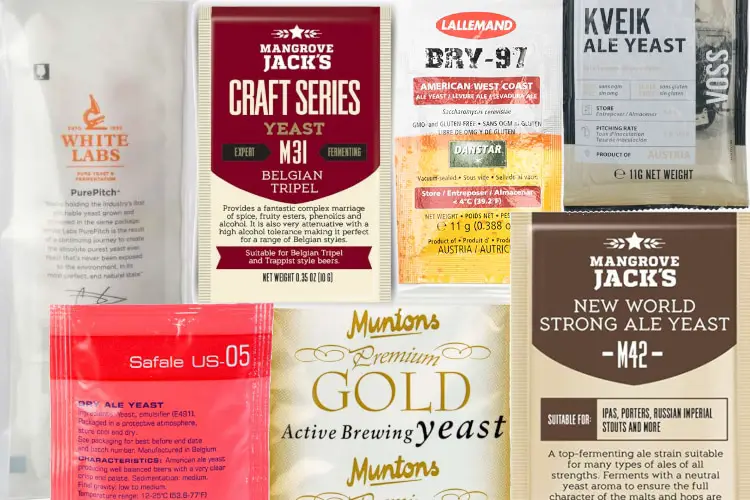According to some…the Germans, there can only be four ingredients in beer. Barley, hops, yeast, and water. They speak from a position of authority as they are arguably the world’s preeminent lager brewers. What about the yeast?
Dry yeast is stable, dependable and the quality has dramatically increased in recent years. Liquid yeast is cultured directly from commercial labs and produces unique qualities inherent to commercial styles. Liquid yeast makes an authentic beer.
Dry Yeast is Suitable for Basic Level Brewers
In the beginning, most folks brew from a hopped extract kit, pour two cans into a pot, boil for 15 minutes, cool a bit, blend with water, pour a small packet of dried yeast powder into your fermenting bucket, and cross your fingers that in two weeks there will be beer.
Your process was quick but sound.
The fermenter was sanitized properly and the airlock bubbled vibrantly for about a week and then settled down for a week before stopping.
When you bottle, you siphon directly from the bottling bucket, hopefully running out the first ½ pint or so out until it clears a bit.
You dropped carbonation drops in the bottles, quick and easy.
Seven days later you crack your first beer, still a little flat but good. So happy!
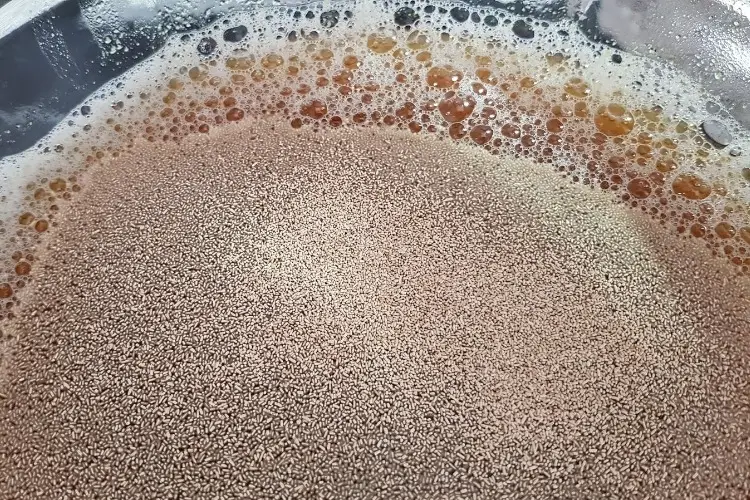
Two weeks later try again. You read up a little.
A friend recommended buying a good beer book.
Boil a little longer, buy a 2nd vessel for racking into for secondary fermentation.
You even add an ounce of real pellet hops to the boil.
Bottle, wait, taste.
You are a home brewer.
Assembling your kit for Brew Day
Barley malt, check, hops, check, bottled spring water, CHECK!
Yeast, oh, I think I still have some somewhere, I think I bought it last year, look way in the back… yeah under the Chinese mustard and duck sauce packets, got it. Yeast.
Brewer in question pulls out a soiled foil pouch, corners blunted, sticky from leaked duck sauce, and printed in fading black Calibri print, YEAST.
Everything is assembled, let’s make some beer.
Make some beer indeed.
Except you forgot the most important thing, your BRAIN.
I kid, I’m a kidder, always been a kidder.
Dry yeast is fine. It can make a fine clean beer.
It is often neutral in character, which for some beers is desirable.
The malt and hop flavors have a chance to develop and showcase their flavors.
Liquid yeast is a pure strain.
It will have no other by-products in it, nor mixed with lesser quality ingredients.
It brings flavor, vibrancy, and a unique animate element missing in dry yeast.
Pros and Cons of dried yeast
| PROS | CONS |
|
|
I encourage you to try dried yeast.
It is perfectly fine for brewing.
When used properly, it attenuates (converts sugar to alcohol) reliably and makes good beer.
When I was starting out in the 90’s there were not so many dried yeasts available.
The internet didn’t exist yet and you were consigned to what was available at the beer supply section of the health food store.
There was Red Star, and the other one, maybe John Bull or Munton’s.
There was also the one that came under the lid of the malt kit can that simply read, 11 g.
Currently, there are no less than two dozen dried varieties available, from a shop or mail order.
Ale, English, Lager, Belgian, hot weather, Asian and…you name it.
As with most things, the variety is now limitless.
The Belgian yeast will have some of that spicy fruitiness.
The lager yeast will ferment at 45°.
The English Ale yeast will work quickly and flocculate (settle out) quickly.
In the end, the flavor profile of dried yeast will be a shadow of the pure strain.
Pure strains come in liquid form, still active live cultures.
It is exceptionally easy to use.
The pros balance well with the cons.
It depends on what you want as a brewer.
Preparing your dried yeast for pitching
You can pour the dried yeast directly in your carboy or fermentation bucket.
If it’s winter and the ambient temperature gets cool at night, the yeast could start off sluggishly, taking up to 24 hours to respire (absorb O2 and multiply).
In this case, it’s better to make a yeast starter.
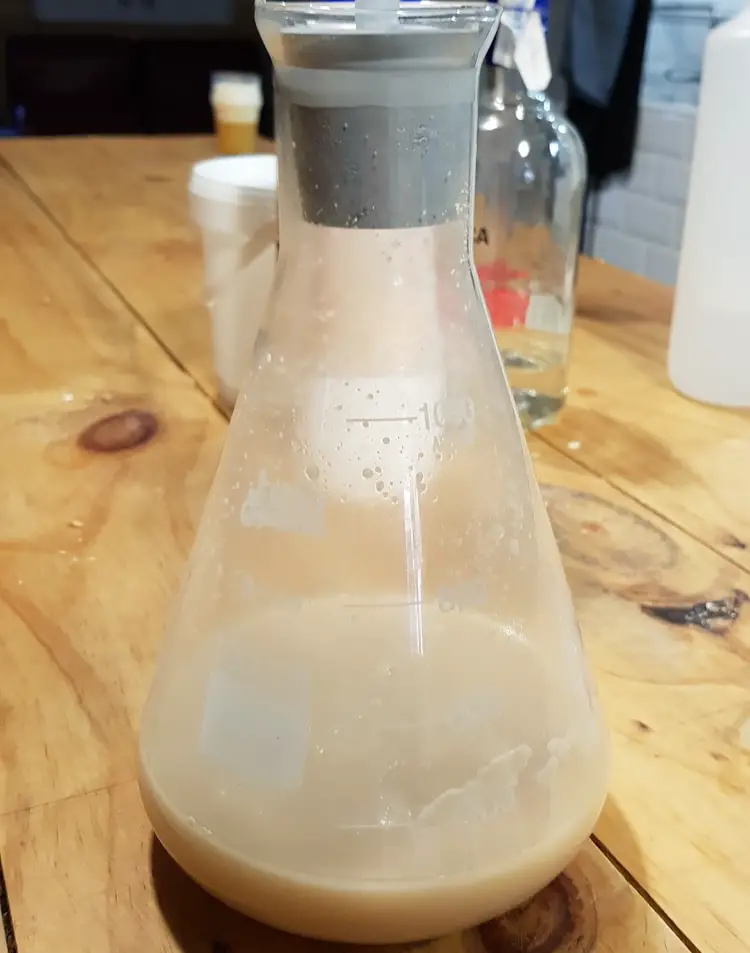
A simple hydration and pitching method – super easy.
- Boil a ¾ cup of water for 5m. Cool it down to 100° F (37° C). It takes just a few minutes.
- Pour it into a sanitized Pyrex measuring cup, or heavy glass. Add the packet of dry yeast and cover it with plastic wrap. Store in the fridge. You can do this while the wort is boiling.
- Pull out of the fridge as the wort cools.
- When the wort cools to 62-64º F (16-17° C) and has been added to the carboy or bucket with the water, as noted, gently pour in the yeast. If your cup doesn’t have a spout, use a small food grade funnel.
- As possible, cap the carboy and tilt the carboy to a 65˚ angle. Resting the glass on something soft shake vigorously to mix yeast and oxygenate wort.
Once the wort, the yeast and everything else is cool, it is susceptible to infection. Bacteria exists everywhere and invades all things.
Make doubly sure anything that touches your cooled beer, raw, fermented, in any stage whatever, has been properly cleaned and sanitized.
Liquid Yeast is Vastly Superior – Full Stop
Liquid yeast more closely resembles commercial brewery yeast than dried.
Commercial liquid yeasts have been cultured from breweries or grown them in labs, excluding proprietary varieties.
They give homebrew beer the most authentic flavor.
Before I congratulated you on making good beer. I would prefer to congratulate you on making Great Beer!
This is what liquid yeast brings to your game.
Twenty-five to thirty years ago when I started out, there were liquid cultures, limited to maybe twelve varieties which took a lot of careful handling and preparation.
I needed to make yeast starters in a timely manner.
The night before I had to grow up the yeast culture before pitching it to guarantee a good cell count.
As the yeast market expanded, new companies emerged which produced pitchable slurries packaged in small handheld vials.
Additionally, there are dozens of varieties offering yeast for virtually any world style.
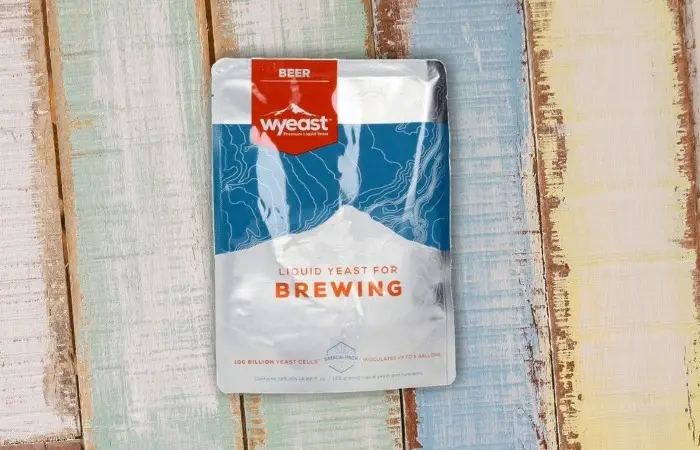
Pros and Cons of liquid yeast
| PROS | CONS |
|
|
My Professional Take on Liquid Cultures
Philosophically, I see the yeast being the core component of the brewing process.
More than any other ingredient, if you change the yeast strain, German to American, British to Belgian, it fundamentally alters the nature and character of the beer.
Distinct yeasts create markedly different taste profiles from the original recipe.
Even if every other ingredient, hops, malts, water, minerals, and sugar are exactly the same, the yeast adds a unique flavor profile.
Very few beer yeasts exist in nature as they appear in the laboratory or brewery.
Wild yeast is an exception which we will touch upon near the end.
A Brief Analogy of Yeasts
Imagine you are cooking for friends from out of town.
Every night will be a new dish.
- Monday, it is country beef stew with salt and pepper. You could also add some sage, cumin and parsley.
- Tuesday, it’s Mexican. You add salt and pepper. You could add chilis, coriander, cardamom, and oregano.
- Wednesday, you cook Italian. You add salt and pepper. You could add fresh oregano, basil, and roasted garlic.
You get the idea.
Your meat and vegetables are garden fresh and locally produced.
These are your malt and hops.
You are not much for spices so add salt and pepper to everything.
Dinner is tasty, and good.
Dried Yeast.
Take the same ingredients, add the fresh herbs and specialty spices to distinguish and define the dish.
Liquid Yeast.
As a brewer yeast was the MOST important ingredient to me.
Nor did I skimp on other ingredients.
I used top-quality American Malt and imported Belgian Candi Sugar (rock candy). I preferred low alpha imported noble (pure strain) hop varieties.
Asheville city water was soft and ranked top five in the nation in purity as it was drawn from reservoirs fed by high-altitude creeks and smog-free mountain rainwater.
The yeast defined the beer and made it special, differentiated not only from other breweries but other beers in your own repertoire.
Origins of Beer Yeast Simplified
Pure yeast strains developed over centuries unique to the regions that utilized them.
Most came from the skin of grapes, apples, or other fruit, present in the white film you can sometimes easily see on grapes and plums.
Over the centuries, humans have learned to isolate the good yeasts from the bad ones, encouraging the flavors we like and minimizing the ones we don’t.
Over time the brewers were able to harvest and reuse the yeast from their breweries, and as microbiology methods developed, purify them and cultivate their own proprietary strains.
A London Ale will taste different than a California one.
A Scottish Ale will taste different than a Belgian Scotch.
Yeasts are part of the fungi family and represent their distinct climate, environment, handing practices and therefore give geographically distinct results.
There are Two True Beer Yeasts
Saccharomyces cerevisiae is ale yeast.
Ale is warm fermented from 59 and 68ºF (15-20° C), occasionally as high as 75ºF (24° C).
Now they have a Scandinavian yeast, Kveik, which ferments well from 74-104° F (24-40° C).
Great Googly Moogly, that is some weird wild stuff, unheard of in my day.
Summer brewing is now possible…go figure!
Ale ferments aggressively and can be finished in as little as a week.
It is a top-fermented beer, meaning it attaches itself to CO2 streams rising to the top of the vessel and can hang out there surfing on the high krausen (foam or “head” on top of your fermenting beer).
Lagers are pitched with Saccharomyces pastorianus, which metabolizes between 40º to 50º F (4-10° C). They require more attention, time, and precision. They are bottom-fermented beers, meaning the yeast spends its time submersed in the beer, gently swimming.
Lager yeast does not swoop and twirl like sea monkeys and may not be skimmed from the top for later use. Not only do lagers require cooler temps, but they take much longer to produce.
Six weeks is barely long enough to produce a good lager, even under factory conditions, regardless of what some brewers will try to tell you!
The original Pilsner Urquell, the Czech lager, is aged in wood for 75 days before packaging; a practice they have followed for 178 years.
Choosing Yeast for Style
I will recount just one brief example.
The Germans created a concept back in 1513 called Reinheitsgebot, that stated only four ingredients were appropriate for beer. It is called the German purity law.
In fact, it was passed under pressure from farmer and baker’s guilds to assure there would always be plenty of wheat, oats, and rye to make bread.
Barley is low in gluten so ideal for beer, not bread.
An unintended result, the purity law also wiped out many local brewing traditions, spice beer and cherry beer among them.
And it also sidelined wheat and rye as brewing agents for many years.
The result was a narrowing of the German scope of brewing, resulting in the domination of Pilsner style, blond, malt heavy beers.
Do not however misconstrue, they are complex, malty, bitter, rich, strong, elegant, you name it they got it, but nonetheless a narrow swath of brewing culture.
The Kölsch beer from Köln and the Altbier from Dusseldorf are two exceptions.
They are German ales and have survived the purity purge.
And wheat beer of course, Weiss bier and Hefeweizen, is an ale and through a technicality falls within the purity law.
Yeast is the primary ingredient that differentiates these German styles, at times uniform, yet in many cases, sublimely perfect.
Wild Yeasts
Just briefly I will recount the unique occurrence of wild yeasts.
In an area in and around Brussels, Belgium, they have successfully brewed beer using wild yeast; that is airborne yeast that inoculates the wort as it sits in wide shallow coolships overnight to cool.
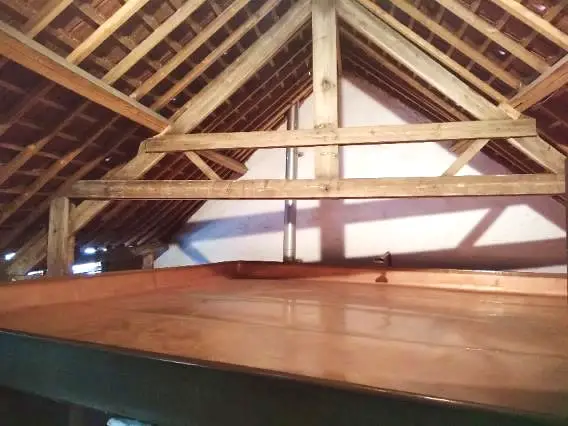
Going back centuries, brewers noticed that beer would naturally ferment, and uncontrolled would often become sour and undrinkable.
With patience and aging, fruit additions and literally centuries of refining technique, these beers have not only become drinkable and highly sought after, but in fact could be considered an art.
Here I refer to Lambic beer of Belgium, as well as Old Browns and many hybrid ales that have been soured.
Available yeast strains include microflora such as Brettanomyces Bruxellensis and Brettanomyces Lambicus.
These are but two of the no less than two dozen wild yeasts that work louvered attics in Northern Belgium where the coolships lie anchored.
You can however, approximate the lambic flavor with the commercial blends.
I do not recommend souring with lactobacillus and calling it lambic style.
It lacks depth, technique, and does injustice to the spirit of the style.
Suffice to say at this moment, sour beers are an acquired taste and one which leaves a lasting impression.
The Final Pitch
Secondary thought fermentation is complete. I feel I have propagated about all the yeast knowledge one may absorb in one sitting.
While I encourage hands-on learning, my goal is to also inoculate younger, less experienced brewers with wisdom and a sense of adventure.
Let your thoughts settle out, clarify, and rest on the bottom for a bit. Dry yeast is absolutely fine. Liquid yeast holds a sublimity that will lead you to great beer, gold medals, and the finest summer barbeques yet imagined.
I hope I have primed your curiosity.
